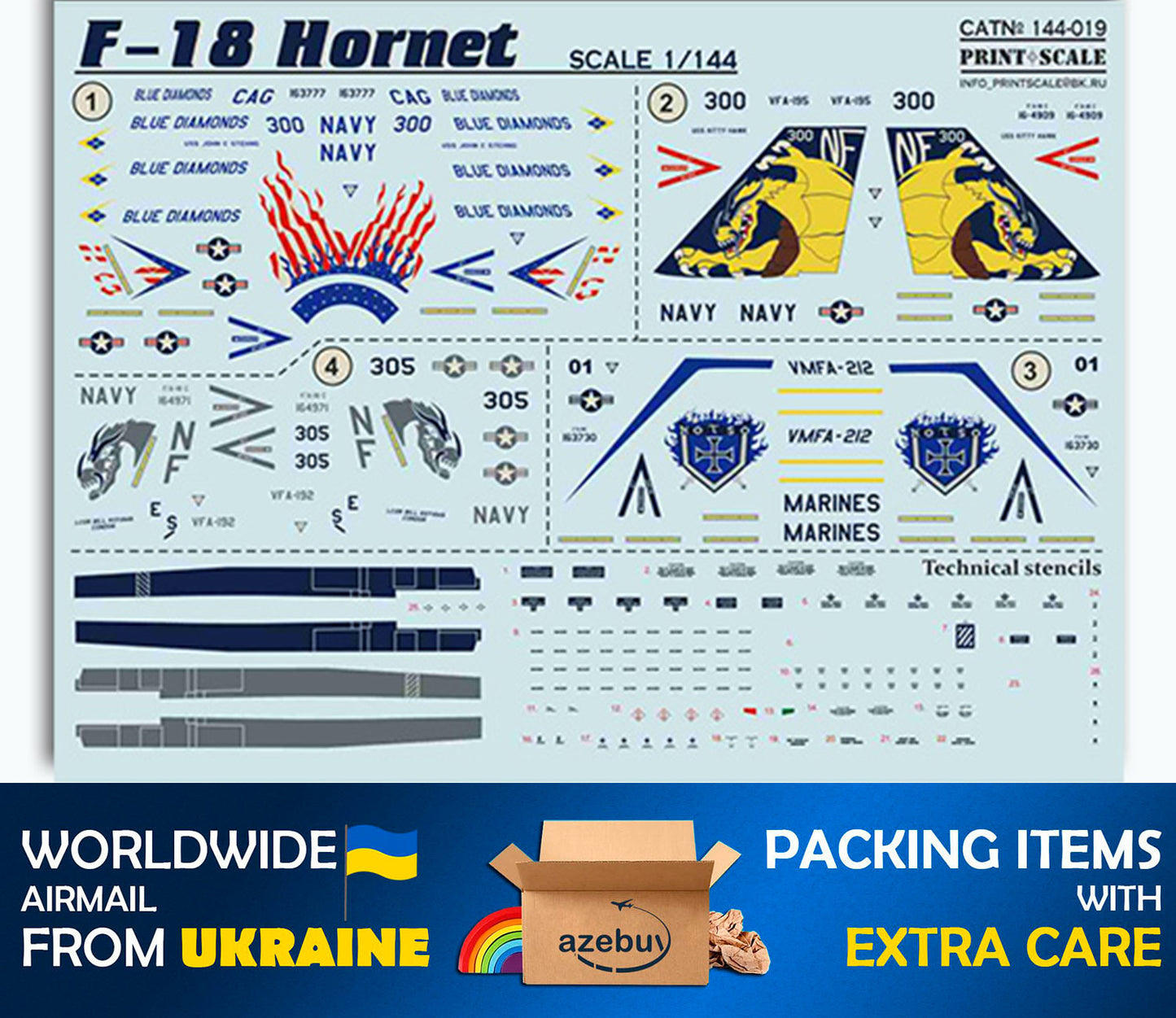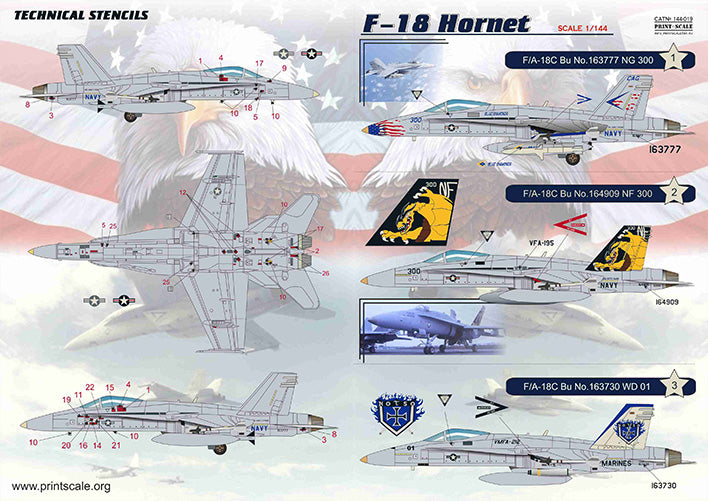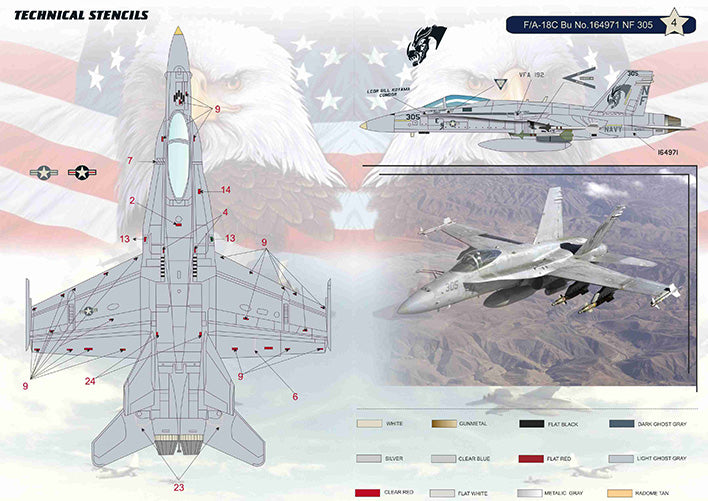1
/
of
3
F-18 Hornet 1983 Year 1/144 Scale Decals Print Scale 144-019
F-18 Hornet 1983 Year 1/144 Scale Decals Print Scale 144-019
Regular price
$10.99 USD
Regular price
Sale price
$10.99 USD
Unit price
/
per
Shipping calculated at checkout.
The Hornet is an American carrier-based fighter-bomber and attack aircraft developed in the 1970s. Today it is the main combat aircraft of the US Navy. It is in service with a number of countries in Europe, Oceania and the Middle East, was used in military operations in Libya, Iraq, Yugoslavia.
The classic Hornet (legacy Hornet, versions F / A-18A, B, C, D) in the US Navy gave way to the Super Hornet (F / A-18E, F) in all combat squadrons. In the United States, as of March 2021, the classic Hornet remained in service only in the Marine Corps, as well as training and experimental squadrons.
In a number of sources, the aircraft is referred to as the F-18, but this designation was abolished in 1982. The correct designation of the aircraft in the US armed forces after 1982, according to the official list of aircraft designations DoD 4120.15-L, May 12, 2004 of the US Department of Defense, is F / A-18 (fighter attack - attack fighter). However, the spelling without the slash is not common and is not commonly found in aviation handbooks. The F-18 designation is officially used by the Finnish Air Force.
The F/A-18's roots go back to an early Northrop design, designated the P.5830 Cobra, designed in the mid-1960s. Subsequently, this project was revised (P.600) and, under the designation YF-17, took part in the US Air Force competition for the creation of a light fighter LWF (Lightweight Fighter). Its competitor was the General Dynamics YF-16 aircraft. In January 1975, the competition ended with the victory of the YF-16, the future F-16 Fighting Falcon. The story of the Northrop aircraft could have ended there, but around the same time, the Air Combat Fighter program for the Navy (NACF, Navy Air Combat Fighter) was launched. Due to the decrease in military spending during this period, the program did not provide for the development of a new aircraft from scratch, but the adaptation of existing projects. The US Navy was skeptical of the single-engine YF-16 and opted for the twin-engined YF-17, which however required significant modifications for naval service. Northrop had not previously been engaged in the creation of carrier-based aircraft, so it was decided that work on the redesign of the YF-17 would be carried out in conjunction with McDonnell Douglas, which has extensive experience in cooperation with the Navy.
The classic Hornet (legacy Hornet, versions F / A-18A, B, C, D) in the US Navy gave way to the Super Hornet (F / A-18E, F) in all combat squadrons. In the United States, as of March 2021, the classic Hornet remained in service only in the Marine Corps, as well as training and experimental squadrons.
In a number of sources, the aircraft is referred to as the F-18, but this designation was abolished in 1982. The correct designation of the aircraft in the US armed forces after 1982, according to the official list of aircraft designations DoD 4120.15-L, May 12, 2004 of the US Department of Defense, is F / A-18 (fighter attack - attack fighter). However, the spelling without the slash is not common and is not commonly found in aviation handbooks. The F-18 designation is officially used by the Finnish Air Force.
The F/A-18's roots go back to an early Northrop design, designated the P.5830 Cobra, designed in the mid-1960s. Subsequently, this project was revised (P.600) and, under the designation YF-17, took part in the US Air Force competition for the creation of a light fighter LWF (Lightweight Fighter). Its competitor was the General Dynamics YF-16 aircraft. In January 1975, the competition ended with the victory of the YF-16, the future F-16 Fighting Falcon. The story of the Northrop aircraft could have ended there, but around the same time, the Air Combat Fighter program for the Navy (NACF, Navy Air Combat Fighter) was launched. Due to the decrease in military spending during this period, the program did not provide for the development of a new aircraft from scratch, but the adaptation of existing projects. The US Navy was skeptical of the single-engine YF-16 and opted for the twin-engined YF-17, which however required significant modifications for naval service. Northrop had not previously been engaged in the creation of carrier-based aircraft, so it was decided that work on the redesign of the YF-17 would be carried out in conjunction with McDonnell Douglas, which has extensive experience in cooperation with the Navy.
Product features
Product features
Materials and care
Materials and care
Merchandising tips
Merchandising tips
Share





